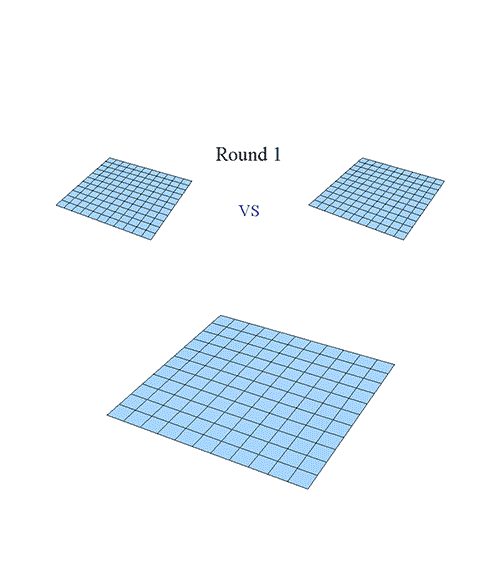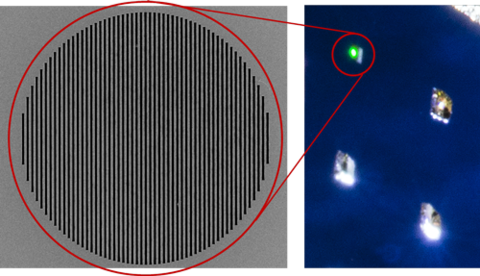
Mode competition in a “phonon laser." A pump power exceeding the threshold level for oscillation of the mechanical modes pictured in the upper half of the figure is turned on, and both modes start to oscillate. The bottom figure shows the actual membrane displacement field, which is the sum of the modes. As the amplitudes ring up from thermal equilibrium, the two modes jostle for the available optically-furnished mechanical gain, giving rise to motion with a swirling, chaotic appearance. Ultimately, however, only one mode can win the battle, and the steady-state motion is that of a single mechanical mode. By controlling the gain characteristics, the experimenters are able to rig the competition to select the winner in advance, or, as pictured here, leave it unpredictable and let Nature decide the outcome. [text description of animation]
Using a novel realization of a "phonon laser," scientists at PML and the Joint Quantum Institute (JQI) have observed and learned to control a process called mode competition. This process occurs routinely in optical lasers, but has never before been seen in analogous optomechanical oscillator systems, which have come to be known as phonon lasers.
In a conventional continuous-wave laser, an optical cavity supporting modes of many discrete frequencies is coupled to a gain medium, which typically has a spectral width encompassing many of the cavity modes. When the gain exceeds the losses for any of the optical modes, that mode starts to oscillate. In many cases, such as gas lasers and dye lasers, the gain medium is inhomogeneously broadened, and many modes can oscillate simultaneously, largely independent of one another.
To force single-mode (monochromatic) operation, it is typical to insert frequency-selective loss elements, such as etalons, in the cavity. In the more ideal case of a homogeneously broadened gain mechanism, multiple modes may start to oscillate, but one dominant mode eventually suppresses the others – hence the term "mode competition" – resulting in a laser's famously monochromatic light.
That phenomenon has been observed for half a century. But it had never been seen in an optomechanical system (in which the output is not coherent photons, but coherent vibrational modes described by quantized excitation states called phonons), even though the advent of the phonon laser in 2009 enabled researchers to realize several other mechanical counterparts to optical laser activity.
John Lawall of PML's Quantum Measurement Division and colleagues from NIST and JQI set out to look for mode competition using a novel phonon laser they devised. (See Fig. 1.)
The team's device employs a Fabry-Perot optical cavity, operated in vacuum, in which one mirror is a thin, specially patterned, silicon nitride membrane. Using the NIST nanofabrication facility (CNST), the researchers patterned the membrane so as to form a sub-wavelength diffraction grating offering a reflectivity of 99.4%. In addition to the optical role the membrane plays in the cavity, it is a mechanical oscillator supporting hundreds of drumhead modes with frequencies upwards of 130 kHz. When light is injected into the cavity, the circulating power becomes very large, and is correlated with the membrane motion. When detuned to the high-frequency side of a cavity resonance, the radiation pressure associated with the circulating power provides mechanical gain. If the gain is sufficient to overcome the intrinsic damping of a particular mechanical mode of the membrane, that mode starts to oscillate. The membrane motion is probed by an auxiliary interferometer beam, not involving the cavity that keeps track of its displacement over time.
The experimenters found that, despite the fact that the mechanical gain couples to hundreds of membrane modes, steady-state operation is always characterized by a single mechanical mode. In other words, their phonon laser behaves in a manner analogous to that of an ideal, homogeneously broadened conventional laser. "As we raise the pump power, out of the multitude of modes in the cavity, there is going to be one that has a lower threshold than all the others," Lawall says. "Once you exceed that threshold, then that first mode will start to oscillate the membrane and increase in amplitude until its gain gets saturated. All other modes will experience a little bit of gain, but not enough to oscillate.

"Then we send in more power until we exceed the threshold for the second-lowest mode. It has a higher threshold because it has a lot more intrinsic damping from the membrane – maybe several times higher than the first mode. But optically, it happens to be much better coupled to the light than the first mode was. So we end up in a situation where that second mode has more damping, but potentially an enormous amount more optical force, resulting in a larger net gain.
"With sufficient pump power, if we wait a few seconds, that second mode can easily have enough gain to overcome its intrinsic damping, and it zooms up and suppresses the first one. In effect, it 'steals' gain from the competing mode and inhibits its oscillation."
By varying the characteristics (power and detuning) of the pump beam, the team found, they could cause any of several modes to dominate. Or they could tune the system into a state of maximum competition and then "let nature decide which one wins," Lawall says.
The researchers were able to calculate the gain analytically, and found that, in addition to predicting mode competition leading to single-mode operation, the calculations made a surprising prediction. Not only does the dominant mode steal gain from the other modes, but if sufficiently strongly driven, it actually reverses the sign of the gain of the weaker modes, causing them to be damped. The experimenters dubbed the phenomenon "anomalous cooling," and found the experiment to be in excellent agreement with the prediction. When the mode with the second-lowest threshold power was oscillating strongly, the mode with the lowest threshold power was optically cooled from room temperature to about 180 K.
The results, recently submitted for publication, add valuable insight into the behavior of optomechanical systems.
"Over the last 50 years, optical lasers have become the staple for optical metrology requiring coherent light at a well-defined frequency," says Garnett Bryant, Leader of PML's Quantum Processes and Metrology Group. "Nanoscale optical lasers have become ubiquitous for commercial applications with the same needs. The results presented here show the way toward the same goal of single-mode operation for applications and metrology where sources of mechanical vibrations are needed."

